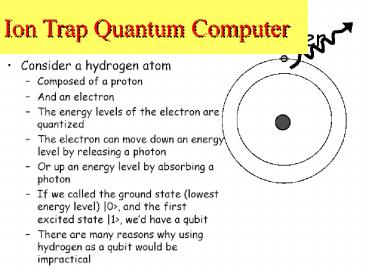Ion Trap Quantum Computer - PowerPoint PPT Presentation
Title:
Ion Trap Quantum Computer
Description:
Each ion can be controlled by a polarized, properly focused laser beam. ... 6: Simple Quantum Gates; http:/www.qubit.org/intros/comp/inset2.html; Mar 2001. ... – PowerPoint PPT presentation
Number of Views:297
Avg rating:3.0/5.0
Title: Ion Trap Quantum Computer
1
Ion Trap Quantum Computer
2
Two Level Atom as a qubit
Electron on lower orbit
Electron on higher orbit
3
Ion Trap Quantum Computer
4
Ion Traps
Linear ion trap
- Ions in a radio frequency trap interact by
exchanging vibrational excitations. Each ion can
be controlled by a polarized, properly focused
laser beam. - Picture shows the electrode structure.
- The electrode is 1mm thick.
5
Linear ion trap computer
Research in NIST
Laser pulses
electrodes
ion
6
(No Transcript)
7
Quantum CNOT gate on beril ion in the trap
Linear ion trap
8
(No Transcript)
9
(No Transcript)
10
(No Transcript)
11
(No Transcript)
12
(No Transcript)
13
Silicon Based Quantum Computer
14
Optical Quantum Computer
15
(No Transcript)
16
What about scaling?
- 1-7 qubits using NMR technology
- 1-2 qubits using ion traps
- 1-2 qubits using various other quantum
technologies - Scaling is very hard!
- Is the problem technical or fundamental?
17
Technical or Fundamental?
- Noise, decoherence, imprecision are detrimental
- Similar problems exist in classical systems
- Theory of linear error correction and fault
tolerant computing can be generalised to the
quantum setting (Shor, Steane, etc.) - Using reasonable physical models, there exist
fault-tolerant schemes for scalable quantum
computing
18
Quantum Circuits
- Quantum Error-Correction Circuit
- Problem State ?? a0? b 1? is degraded by
noise
- Solution Encode in a suitable EC code such as the
5-bit code - 0? 00000? 11000? 01100? 00110?
00011? 10001? 10100? 01010?
00000? 10010? 01001? - 11110? 01111? 10111? 11011?
11101? - 1? 11111? 00111? 10011?
19
Summary
20
Summary
- Quantum Computers are a natural generalisation of
classical computers - Quantum algorithms Factoring, Discrete log,
Hidden Subgroup, Hidden Affine Functions,
Searching, Counting - Small implementations exist
- Scaling is difficult, but seems to be a
technological (not fundamental) problem
21
References
- 1 Chuang, Issac and Gershenfeld, Neil Quantum
Computing With Molecules Scientific American
June 1998. - 2 Hey, Anthony Possible Technologies for
Quantum Computers May 1998 http//www.ecs.soton.
ac.uk/ajgh/quantrep.html - 3 Nuclear Magnetic Resonace Quantum Computers
http//www.qubit.org/research/NMR/index.html - Mar 2001.
- 4 Quantum Computing Experiment At Los Alamos
http//p23.lanl.gov/Quantum?qcexper.html - Jan 2001.
- 5 QUIC Milestones http//theory.caltech.edu/qu
ic/milestones.html - Mar 2001.
- 6 Simple Quantum Gates http/www.qubit.org/intr
os/comp/inset2.html - Mar 2001.
- 7 Waldtrop, M Quantum Computing Technology
Review May/June 2000.
22
Physical Implementation NMR
- Five-qubit computer (contd.)
- Molecule with 5 flourine atoms
- whose spins implement the qubits
- Experimental 5-qubit circuit to find the order of
a permutation
Quantum Fourier Transform
measurements































